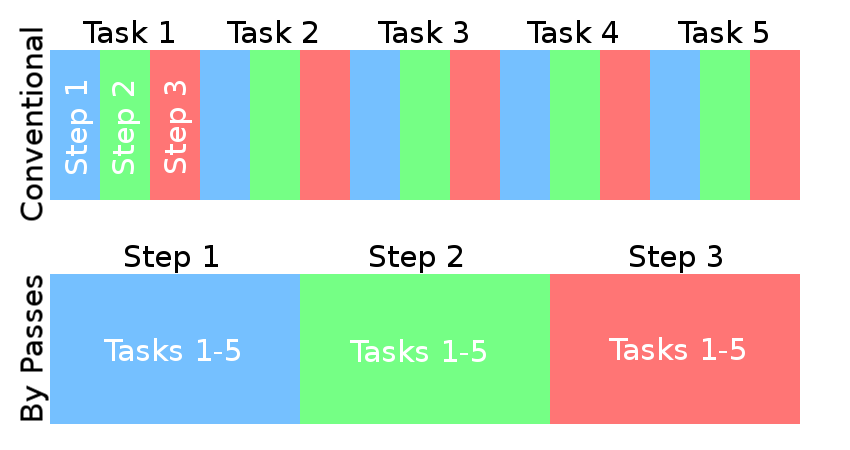
Living in Passes
By Jonathan Lam on 12/27/17
Tagged: brain-dump reflection
Previous post: Why I'm Against Prom
Next post: Frowns and smiles, baldness, sleep
- Sorting algorithms.
- College applications.
- Matrix multiplication.
- Annotated bibliographies.
- Coding projects.
- Studying classes.
What do these all have in common? Each one comprises multiple tasks that themselves require multiple disparate steps.
I was finishing up college applications in the last few days, and my sister asked me about my progress. I told her that I had finished most of the essays, especially the engineering and extracurricular essays, but had not finished all of the creative writing or school-specific essays. She thought it would have been easier had I simply finished each one, one at a time, instead of working on it in parts. I disagree.
It's a common problem I encounter when doing my homework. What homework should I complete first? And it turns out that for large homework assignments and projects, I tend to finish them all at once instead of each one separately. (Smaller homework assignments are essentially atomic operations and can be completed first.) There are many benefits to taking a non-linear approach to larger tasks like this, including:
- Less chance of losing interest or build dread
- Ability to think about assignments while completing another (i.e., breathing time)
- Finding patterns in the tasks to optimize in future runs
- Having less pause before completing dissimilar tasks (e.g., group similar tasks together and perform them more quickly)
The latter is especially helpful. One particular instance in which this helps enormously is when completing annotated bibliographies for English class. The structure for an annotated bibliography is:
- MLA bibliography citation of the source.
- State title, author, genre, and main idea of source.
- Include an interesting / main contention of the source, including a quote.
- Relate to another source from the class
It's very slow to do each one separately, remembering again how to cite the source in an MLA form, quote, looking over all of the past bibs to see which texts have already been related to to avoid repetition. But if you do all of the bibliographies at once, and then all of the title/author/genre/main idea straightforward points, and then you blaze through all of the texts for quotes, and then do all of the relating while you still remember which sources have been connected to already, then it goes much quicker. I would estimate that it would take three to four school nights using the conventional method, whereas a method "by passes" would take only a single one.

While it seems that both methods should take the same amount of time, every time a different step is taken there's some overhead in switching mindsets to accomodate a new task. In the conventional method, you can see that there are many switches in the steps (color switches), whereas in the method by passes, there are only as many as there are steps. If you have many tasks at hand (e.g., in the annotated bibliographies, when thirty annotated bibs were due), then it requires much more time doing something the conventional way than doing it by passes (in which there are only four steps, and hence only three switches).
This "overhead" of switching comprises of the wave of dread of starting something new, like beginning a long road run in cross country or building another coding project. Every switch makes the problem seem longer.
The logical question now is, what happens if there are many steps and fewer tasks? Or if there is a hodgepodge of different tasks with few similarities in their steps? It would seem to reverse this logic, and make it simpler to go the conventional way. But that's rarely true, because many projects can be broken down into the same fundamental steps (planning, execution, analysis, redesign) that can be used as like steps. But even if this is not the case, it still allows a person to lose less interest by changing the subject frequently and giving time to think about other projects.
So if a person had to work on a Statistics surveying project, a programming bowling website, and study for a Spanish final all at the same time, then the best way to approach it is to plan each one out, interlace the executions, analyze them all at once (perhaps even drawing interesting conclusions from the other projects), and then focusing on improvements for future trials (again, taking into consideration the other projects).
To clarify, this is not attempting to multi-task. This is simply re-organizing the order in which the steps of multiple tasks are completed. Think of it like multiplication, which is commutative and thus can be calculated with either factor first.
By passes | Conventional
-------------+---------------
24 <- tasks | 3 <- steps
* 3 <- steps | * 24 <- tasks
--- | ----
72 | 12
| + 60
| ----
| 72
Going by passes almost always is the quicker way.
